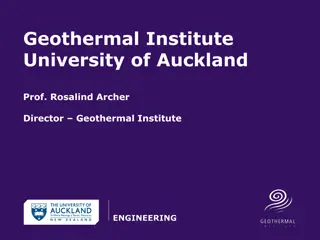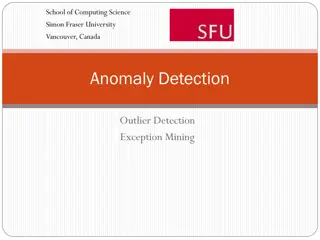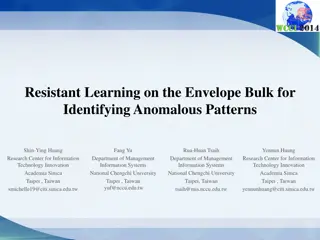Intelligent Outlier Detection Algorithm by Andrew Weekley at National Renewable Energy Lab
This project focuses on an intelligent outlier detection algorithm developed by Andrew Weekley at the National Renewable Energy Lab. The algorithm involves identifying suspect data in time series using statistical calculations. Optimal clusters in time and delay spaces are utilized to build features, and simulated examples demonstrate the application of machine learning algorithms. References to related works by Weekley and others are provided.
Download Presentation

Please find below an Image/Link to download the presentation.
The content on the website is provided AS IS for your information and personal use only. It may not be sold, licensed, or shared on other websites without obtaining consent from the author.If you encounter any issues during the download, it is possible that the publisher has removed the file from their server.
You are allowed to download the files provided on this website for personal or commercial use, subject to the condition that they are used lawfully. All files are the property of their respective owners.
The content on the website is provided AS IS for your information and personal use only. It may not be sold, licensed, or shared on other websites without obtaining consent from the author.
E N D
Presentation Transcript
Intelligent Outlier Detection Algorithm Andrew Weekley National Renewable Energy Lab Andrew.weekley@nrel.gov
Acknowledgments Co-investigators Kent Goodrich (CU Boulder Dep. of Math, NCAR) Larry Cornman (NCAR) Work originally funded by the National Center for Atmospheric Research Work performed while employed by NCAR
Finding Suspect Data Humans can identify suspect data in a time series with little or no information Finding suspect data with a computer may involve calculating a statistic The statistic may be used to identify the suspect data But the suspect data corrupts the statistic And depending on the situation the statistic may not identify the suspect data
Optimal clusters optimal clusters in time domain and delay space build a feature in the time domain from optimal clusters in the time domain drop-out and non-stationary cases have two optimal clusters in delay space, but distinct representations in the time domain. nominal, block and uniform cases have single clusters in delay space but distinct representations in the time domain
Simulated example Identified a set of feature vectors which could be used in a machine learning algorithm such as SVM Build a training data set using simulated data
References Ma, J., and S. Perkins, 2003: Time-series novelty detection using one-class support vector machines. Proceedings of the International Joint Conference on Neural Networks, 2003., Vol. 3 of, IEEE, 1741 1745 Weekley, R. A., R. K. Goodrich, and L. B. Cornman, 2003: Fuzzy Image Processing Applied to Time Series Analysis. 3rd Conference on Artificial Intelligence Applications to the Environmental Science, Vol. 54 of, Citeseer, 258 Weekley, R. A., R. K. Goodrich, and L. B. Cornman, 2004a: Feature Classification for time series data. US Patent 6,735,550. Weekley, R. A., R. K. Goodrich, and L. B. Cornman, 2010: An Algorithm for Classification and Outlier Detection of Time-Series Data. Journal of Atmospheric and Oceanic Technology, 27, 94 107, doi:10.1175/2009JTECHA1299.1.























